Kaplan NCLEX RN Exam 214 Questions with Verified Answers ,100% CORRECT
Document Content and Description Below
Kaplan NCLEX RN Exam 214 Questions with Verified Answers WBC count - CORRECT ANSWER 4,500-11,000 Hemoglobin normal range - CORRECT ANSWER male 13-18 female 12-16 RBC count - CORRECT ANSW... ER male 4.6 - 6.2 female 4.2 - 5.4 Hematocrit range - CORRECT ANSWER Male 42-52% Female 35-47% PTT purpose - CORRECT ANSWER monitors effectiveness of heparin therapy; detects coagulation disorders PTT (partial thromboplastin time) - CORRECT ANSWER lower limit of normal: 20-25 sec upper limit of normal: 32-39 Platelet count - CORRECT ANSWER 150,000-400,000 Prothrombin Time (PT) - CORRECT ANSWER 9.5-12 seconds INR (international normalized ratio) - CORRECT ANSWER 1 sec 2-3 sec for afib therapy, DVT, and PE 2.5-3.5 sec for prosthetic heart valve therapy glucose tolerance test (GTT) - CORRECT ANSWER fasting: 70-99 1 h: 190 2 h: 140 3 h: 125 total cholesterol - CORRECT ANSWER 150-200 mg/dL LDL - CORRECT ANSWER <100 mg/dL The lower the better HDL - CORRECT ANSWER male: 35-70 female: 35-85 creatinine (CR) - CORRECT ANSWER 0.7-1.4 mg/dL BUN normal range - CORRECT ANSWER 10-20 mg/dL serum albumin - CORRECT ANSWER 3.5-5.5 g/dL nutritional status Triglycerides - CORRECT ANSWER detect for atherosclerosis 100-200 mg/dL ALT range - CORRECT ANSWER 7-56 units/L AST range - CORRECT ANSWER 10-40 units/L What is diabetes inspidus (DI)? - CORRECT ANSWER decrease in secretion of ADH (or vasopressin) by the pituitary Effects of DI - CORRECT ANSWER diuresis increases; dehydration DI treatment - CORRECT ANSWER give IV fluids, electrolyte replacement, DDVAP (desmopressin) to prevent further dehydration S/s of DI - CORRECT ANSWER increased urine output, increased plasma osmolarity, urine specific gravity 1.001-1.005, excessive thirst, wt loss, weakness, constipation systemic lupus erythematosus (SLE) - CORRECT ANSWER chronic inflammatory (multisystem) autoimmune disease involving joints, skin, kidneys, CNS, vascular/lymphatic problems, heart, and lungs SLE interventions - CORRECT ANSWER Monitor for fever, relieve pain (NSAIDs, acetaminophen), antimalarial meds, protect from UV rays/sunlight, corticosteroids, teach lifestyle changes to prevent infection and decrease risk of CAD hypotonic solution - CORRECT ANSWER Solute concentration is less than that inside the cell; cell gains water 0.45% isotonic solution - CORRECT ANSWER same concentration as ECF 0.9% NaCl Lactated Ringers 5% dextrose in water (starts as this) hypertonic solution - CORRECT ANSWER solute concentration is greater than than inside of cell; cell lose water 3% NaCl 10-15% dextrose in water 5% sodium bicarbonate D5NS gravida - CORRECT ANSWER total number of pregnancies regardless of duration, includes present pregnancy para - CORRECT ANSWER number of past pregnancies beyond period of viability (20 wks gestation or greater) regardless of number of fetuses or whether infant was born alive or dead Pregnancy danger signs - CORRECT ANSWER leaking amniotic fluid, vaginal bleeding, severe HA, abd pain, persistent vomiting, fever, chills, swelling in face and fingers Normal pH of urine - CORRECT ANSWER 4.6-8 Positive sweat test - CORRECT ANSWER finding for cystic fibrosis Cystic fibrosis diet - CORRECT ANSWER high calorie, high protein, tolerated fat liberal intake of fluids unless contraindicated pancreatic enzyme replacement required What is cystic fibrosis? - CORRECT ANSWER Inherited respiratory disease Dysfunction in sweat glands, respiratory, and GI system (esp. pancreas) Obstructions r/t flow of thick mucus, sweat, saliva, and digestive secretions Cystic fibrosis treatment - CORRECT ANSWER postural drainage, chest physiotherapy, expectorants, mucolytic agents, replace pancreatic enzymes, aerosol therapy UTI S/s - CORRECT ANSWER urinary frequency and urgency burning, pain with voiding possibly visible blood or pus in urine S/s of Pyelonephritis - CORRECT ANSWER inflammation of kidney chills, fever, malaise, flank pain, CVA tenderness S/s of Cystitis - CORRECT ANSWER bladder inflammation burning and pain on urination, urinary frequency/urgency, bladder spasms S/s for all hepatitis - CORRECT ANSWER jaundice, anorexia, RUQ abd pain, clay colored stool, brown urine, pruritus Hepatitis diet - CORRECT ANSWER low fat, high carb, high protein, no alcohol Color of Lochia (by day) - CORRECT ANSWER Day 1-3: rubra Day 4-9: serosa Day 10+: alba S/s of Meningitis - CORRECT ANSWER HA, fever, photophobia, changes in LOC, motor seizures Signs of meningeal irritation: nuchal rigidity, Kernig's sign, Brudzinski's sign, Opisthotonus position Kernig's sign - CORRECT ANSWER Severe stiffness of the hamstrings causes an inability to straighten the leg when the hip is flexed to 90 degrees. Brudzinski's sign - CORRECT ANSWER Severe neck stiffness causes a patient's hips and knees to flex when the neck is flexed. Opisthotonus position - CORRECT ANSWER dramatic abnormal posture, produces severe backward arching from neck to heel S/S of meningitis in infants - CORRECT ANSWER refuse feedings, V/D, bulging fontanelles, vacant stare, high pitched cry CCB meds - CORRECT ANSWER Amlodipine, Diltiazem, Nicardipine, Nifedipine, Verapamil CCB action - CORRECT ANSWER decrease HR and cause vasodilation of peripheral vasculature CCB AEs - CORRECT ANSWER peripheral edema, hypotension, dizziness, HA CCB contraindications - CORRECT ANSWER decreased cardiac conduction disorders, HF, SBP < 90 Common opportunistic infection in AIDS - CORRECT ANSWER Pneumocystis jiroveci pneumonia AIDS nursing care - CORRECT ANSWER offer high protein, high caloric diet; monitor vital signs, chest sounds, suction, signs of secondary infection; maintain O2 as prescribed S/s of upper respiratory infection - CORRECT ANSWER rhinorrhea, nasal congestion/discharge, sneezing, teary watery eyes, sore throat S/s of sinusitis - CORRECT ANSWER facial pressure, stuffy nose, purulent nasal discharge, HA, ear pain, dental pain Tx for Pertussis (whooping cough) - CORRECT ANSWER Macrolide ABX, do not use cough suppressants or antihistamines, do not use cortisone or bronchodilators S/S of preeclampsia - CORRECT ANSWER - BP: SBP > 140 and/or 90 diastolic mmHg Occurs 2x (4-6 hours apart) - Proteinuria >0.3 g/24 hours Protein/creatinine ratio >0.3 - Platelets > 100,000 - HA, visual changes, edema Preeclampsia care - CORRECT ANSWER bed rest in left lateral position, well-balanced diet, daily weights Preeclampsia with severe features - CORRECT ANSWER - BP: 160/110 or higher - Proteinuria not necessary - HA, RU epigastric pain, dizziness, visual changes, anginal pain Severe preeclampsia care - CORRECT ANSWER bed rest, monitor I/Os, seizure precautions, VS, fetal heart tones, give antihypertensive meds S/s of eclampsia - CORRECT ANSWER most serious form of toxemia during pregnancy - HTN, proteinuria, edema, motor seizures (tonic-clonic) - occurs between 20-40 weeks of pregnancy eclampsia care - CORRECT ANSWER bedrest in left lateral position, monitor I/Os, VS, fetal heart tones, seizure precautions, give magnesium sulfate (anticonvulsant), hydralazine (vasodilator), diazepam (sedative, anxiolytic), nifedipine (CCB), well-balanced diet, daily weights Food to avoid in pregnancy - CORRECT ANSWER raw eggs, shellfish, or fish fish with mercury: swordfish, tuna unpasteurized milk or dairy products, soft cheeses processed/deli meats: bologna, salami, hot dogs S/S of ectopic pregnancy - CORRECT ANSWER severe, unilateral, lower abd pain pain referred to shoulder abd rigidity bleeding low hct and low HCG levels ectopic pregnancy care - CORRECT ANSWER assess for hemorrhage and shock provide fluid support prepare for surgery give Rho(D) immune globulin if Rh-negative emotional support Placenta previa - CORRECT ANSWER placenta grows over cervix S/s: intermittent, painless bleeding during pregnancy Placental abruption - CORRECT ANSWER placenta pulls away from the uterine wall S/s: hard abdomen, painful, sudden bleeding HELLP syndrome - CORRECT ANSWER hemolysis, elevated liver enzymes, low platelets *Can lead to DIC placenta previa risk factors - CORRECT ANSWER hx of placenta previa prior c-section multiparity advanced maternal age smoking placental abruption risk factors - CORRECT ANSWER maternal HTN, cocaine use, blunt external abdominal trauma, maternal abuse, multiparity, smoking, premature rupture of membranes, hx of placental abruption What does alpha-fetoprotein (AFP) test for? - CORRECT ANSWER neural tube defects Results: increased = neural tube defects; decreased = Down syndrome When is AFP screening done? - CORRECT ANSWER 16-18 weeks *has high rate of false positives What does chorionic villus sampling show? - CORRECT ANSWER detects chromosomal abnormalities (i.e. PKU, sickle cell, Duchenne) When is chorionic villus sampling done? - CORRECT ANSWER 8-12 weeks *Done with full bladder, may give RhoGAM afterwards What does amniocentesis show? - CORRECT ANSWER genetic disorder or lecithin-spingomyelin (L/S) ratio to detect lung maturity (2:1) When is amniocentesis performed? - CORRECT ANSWER usually 16 weeks or later *bladder should be empty if >20 weeks, may give RhoGam afterwards Nonstress and contraction stress test - CORRECT ANSWER done after 28 weeks usu. for high-risk pregnancy; assess fetal well-being US records fetal movement and records fetal heart rate Nonstress test (NST) result - CORRECT ANSWER Reactive = 2+ fetal HR accels of 15 bpm lasting 15 sec over 20 min period with return to baseline Nonreactive = may need CST or immediate delivery Contractions stress test (CST) result - CORRECT ANSWER Positive = bad; late decels with minimum of 3 contractions; may need immediate delivery Negative = good outcome; no late decels with minimum of 3 contractions Immunizations during pregnancy - CORRECT ANSWER Safe: flu, Tdap Avoid: live vaccines including MMR, varicella, and herpes zoster (may give post delivery) Responding to fetal distress - CORRECT ANSWER LIONS: Left side (if no change, trendelenburg or knee chest) IV fluids O2 by mask Notify HCP Stop labor-inducing meds APGAR - CORRECT ANSWER HR: absent = 0, <100 = 1, >100 = 2 Respiratory effort (Cry): absent =0, slow/irregular/weak cry = 1, good cry = 2 Muscle tone: flaccid/limp = 0, some flexion of extremities/sluggish = 1, well flexed/actively moving/strong = 2 Reflex response: no response = 0, grimace upon stimulation= 1, vigorous cry = 2 Color: blue/pale = 0, blue/pink = 1, all pink = 2 Scores: 0-3 = poor 4-6 = fair 7-10 = excellent Leading causes of CKD - CORRECT ANSWER DM and HTN Other: glomerulonephritis, interstitial cystitis, polycystic kidney disease, pyelonephritis, exposure to nephrotoxic meds and chemicals, and obstructive urinary tract disease Normal function of kidneys - CORRECT ANSWER remove waste (urea and creatinine) filter and remove excess insulin excrete excess K+ regulate NA and H2O Control BP through RAAS Make erythropoietin which stimulates production of RBCs in bone marrow activate vitamin D regulate acid-base balance What is ptosis? - CORRECT ANSWER drooping eyelid *can indicate exacerbation of myasthenia gravis Immunizations due at 2 months old - CORRECT ANSWER Rotavirus DTaP Haemophilus influenzae type B (Hib) Inactivated poliovirus Streptococcus pneumoniae Neuroleptic Malignant Syndrome - CORRECT ANSWER Adverse reaction to antipsychotics S/s: rigidity, fever, sweating, autonomic dysfunction (dysrhythmias, fluctuations in BP), confusion, seizures, coma Neuroleptic malignant syndrome care - CORRECT ANSWER Stop antipsychotic meds, control hyperthermia (cool the body), hydration, dantrolene (muscle relaxant) for rigidity and severe reactions, bromocriptine (dopamine receptor antagonist) used for CNS toxicity and mild reactions acute dystonic reaction - CORRECT ANSWER AE of antipsychotic meds S/s: muscle spasms of the neck, face, and back within a few days of starting treatment with the drug PVC (Premature Ventricular Contraction) - CORRECT ANSWER in many cases no P wave followed by a large QRS complex that is premature, followed by a compensatory pause Vfib - CORRECT ANSWER No P waves No QRS complex Chaotic Rhythm **Intubation, rapid D-Fib, Epinephrine, Lidocaine Carbamazepine - CORRECT ANSWER Anticonvulsant AE: myelosuppression, rash Care: monitor I/Os, CBC, supervise ambulation Teach: take with meals, protect from sun, do not decrease dose or discontinue abruptly phenytoin - CORRECT ANSWER Anticonvulsant AE: lethargy, GI upset, gingival hypertrophy Care: never mix with other IV meds or dextrose Teach: take with at least 1/2 glass of water or meals; sweat, urine might become red-brown or pink; oral hygiene; alcohol increases serum levels Anticonvulsants - CORRECT ANSWER clonazepam, DIAZEPAM, fosphenytoin, levetiracetam, PHENYTOIN sodium, primidone, magnesium sulfate, valproic acid, carbamazepine, ethosuximide, gabapentin, lamotrigine, topiramate Anticonvulsants AE - CORRECT ANSWER CV depression, respiratory depression, agranulocytosis, aplastic anemia Teach: tolerance develops with long term use, don't discontinue abruptly; caution use with MAOIs, increased risks for elderly hyperthyroidism / grave's disease - CORRECT ANSWER autoimmune; abnormally high secretion of thyroid hormones, increases metabolism S/S of hyperthyroidism (Graves Disease) - CORRECT ANSWER goiter caused by too much production of T3 and T4and decreased TSH tachycardia/palpations heat intolerance increased metabolic rate/wt loss insomnia/nervousness exophthalmos (protruding eyes) Erikson stages of development - CORRECT ANSWER 1. trust vs mistrust (birth-12months) 2. autonomy vs shame/doubt (12months-3years) 3. initiative vs guilt (3-6years) 4. industry vs inferiority (6-12years) 5. identity vs role confusion (12-20years) 6. intimacy vs isolation (20-40years) 7. generativity vs stagnation (40-65years) 8. ego integrity vs despair (65+years) Infant reflexes - CORRECT ANSWER Stepping (up to 4 weeks) Tonic neck (3-4 months) Moro (3-4 months) Babinski (24 months - reverts to adult response) Palmar (3-4 months) Rooting (4-7 months) Plantar (8 months) s/s of tonsillitis - CORRECT ANSWER Sore throat Fever/chills Elevated WBC Positive throat culture Dysphagia Anorexia Muscle aches Headache Foul breath Exudate on tonsils Swollen lymph nodes on neck s/s of epiglottitis - CORRECT ANSWER drooling dysphagia dysphonia distressed respiratory effort high fever rapid onset tripoding s/s of bronchiolitis - CORRECT ANSWER Rhinorrhea Congestion Cough, increased work of breathing Hypoxemia Tachypnea Retractions with diffuse wheezes and crackles *RSV related RSV (respiratory syncytial virus) - CORRECT ANSWER highly contagious viral respiratory infection, major cause of respiratory illness in young children Tetralogy of Fallot - CORRECT ANSWER congenital malformation involving four distinct heart defects - interventricular septal defect - pulmonic stenosis - overriding aorta (receives blood from both ventricles) - right ventricular hypertrophy S/s of tetralogy of fallot - CORRECT ANSWER *cyanosis - hallmark (blue spells or tet spells) murmur clubbing of fingers delayed physical growth and development squatting NSAID AE - CORRECT ANSWER Bleeding (esp. GI) Heartburn Nausea Anaphylaxis HA Dizziness Types of NSAIDs - CORRECT ANSWER aspirin, ibuprofen, naproxen, diclofenac, indomethacin, ketorolac, nabumetone, sulindac, celecoxib acetaminophen (similar NSAID properties except antiinflammatory) leukopenia precautions - CORRECT ANSWER meal well done brush and floss after every meal no exposure to dirt (gardening) no exposure to fresh-cut flowers rinse toothbrush w/ bleach solution no alcohol based mouthwash bathe daily w/ antimicrobial soap nothing fresh (veggies, fruit, ground pepper) eat refrigerated leftovers within 24 hours S/s of fluid volume overload - CORRECT ANSWER increased, bounding pulse increased RR with SOB crackles JVD decreased HCT and BUN increased weight elevated BP angina pectoris (chest pain) - CORRECT ANSWER retrosternal (or slightly left of sternum), radiates usu. to left shoulder and down arm into fingers; may radiate to right shoulder, neck, jaw, or epigastrium usu. lasts < 5 minutes aggravated by activity relieved by rest and nitroglycerin Infective endocarditis - CORRECT ANSWER infection of heart lining and valves S/s: fever, malaise, back and joint pain, splinter hemorrhages under fingernails and toenails, petechiae in conjunctiva and mucous membranes, heart murmur, roth spots (retinal hemorrhages) cardiac tamponade - CORRECT ANSWER acute compression of the heart caused by fluid accumulation in the pericardial cavity causes decreased venous return to the heart decreased CO S/s: decreased SBP, narrowing pulse pressure, increased venous pressure, muffled heart sounds Care: assess for pulsus paradoxus (SBP is lower during inhalation than exhalation); hemodynamic status; assist with pericardiocentesis Cor Pulmonale - CORRECT ANSWER right ventricle fails as a result of pulmonary condition S/s: exertional dyspnea, productive cough, fatigue, weakness, JVD, peripheral edema Care: rest, fluid restriction, diuresis, monitor VS, cardiac rhythm, ABGs, I/Os, weight Pericarditis - CORRECT ANSWER inflammation of the pericardial sac S/s: sharp chest pain, sudden, severity changes with position changes; pericardial friction rub, may have fever Tx: NSAIDs, corticosteroids, specific therapies for bacterial infection or autoimmune disorders Normal troponin level - CORRECT ANSWER < 0.04 ng/mL S/s of MI - CORRECT ANSWER severe crushing chest pain, may radiate to arms, jaw, neck, back dyspnea N/V gastric discomfort, indigestion apprehension, restlessness fear of death Diagnostic enzymes for MI - CORRECT ANSWER Creatine kinase (CK) increases in 3-6 hours, peaks 24-36 hours, normal by day 3 Isoenzyme (CK-MB) increases 4-8 hours, peaks in 12-24 hours, normal in 3-4 days Myoglobin increases 1-3 hours; returns to normal 12 hours after MI Troponin T and I increases 3-4 hours, peaks 4-24 hours, returns to normal in 1-3 weeks TIA - CORRECT ANSWER transient interruption of blood flow to the brain, stroke warning sign Risk factors: AFib, high cholesterol, HTN, DM, family hx, >65 years old S/s: usu. last minutes to hours, related to location of ischemia Diagnostics: CT scan, MRI, cerebral angiography, 12 lead EKG, carotid ultrasound Magnesium sulfate AE - CORRECT ANSWER weak or absent DTRs hypotension respiratory paralysis depressed cardiac function hypocalcemia Care: respirations should be >16 before giving IV, test knee jerk and patellar reflexes before each dose; monitor VS and I/Os SSRIs - CORRECT ANSWER Ex: Sertraline hydrochloride, fluoxetine, citalopram, paroxetine Use: depression, OCD, obesity, bulimia AE: HA, dizziness, nervousness, N/D Insomnia or drowsiness sexual dysfunction weight gain *Take in the am *Don't take with MAOIs or St. John's wort Care: monitor for confusion, thrombocytopenia, leukopenia, and anemia SNRIs - CORRECT ANSWER Ex: duloxetine, venlafaxine AE: CNS depression N, HA, insomnia HTN *Use caution with pts who have seizure disorder, HTN, liver or kidney problems *Taper meds to avoid discontinuation syndrome (withdrawal) MAOIs - CORRECT ANSWER older generation, more side effects Ex: isocarboxazid, phenelzine, tranylcypromine Use: depression, chronic pain syndromes AE: anticholinergic, effects photosensitivity sexual dysfunction weight gain orthostatic hypotension CNS stimulant hypertensive crisis - by eating foods containing tyramine or tryptophan rich foods (chocolate, aged cheese, liver, yeast, pickled products, beer, yogurt) *Avoid other MAOIs, antidepressants, OTC cold remedies *Caution with pts who have diabetes, glaucoma, HTN *need a washout period of several weeks to clear drug Serotonin syndrome symptoms - CORRECT ANSWER agitation or restlessness insomnia confusion tachycardia and HTN dilated pupils loss of muscle coordination or twitching muscles muscle rigidity Lithium - CORRECT ANSWER SE: Polyuria Therapeutic range: 0.8 to 1.2 mEq/L Toxicity > 1.5 mEq/L S/s: D/V, stomach pain, tremors, muscle weakness, rapid HR *Encourage hydration schizoaffective disorder - CORRECT ANSWER Psychotic disorder featuring symptoms of both schizophrenia and major mood disorder. paranoid schizophrenia - CORRECT ANSWER preoccupation with delusions or hallucinations, often with themes of persecution or grandiosity psychosis - CORRECT ANSWER loss of contact with reality Schizophrenia (positive symptoms) - CORRECT ANSWER hallucinations, delusions, thought disorders, movement disorders Schizophrenia (negative symptoms) - CORRECT ANSWER flat affect anhedonia reduced speaking withdrawal lack of motivation Schizophrenia cognitive symptoms - CORRECT ANSWER difficulty focusing problems with "working memory" poor executive functioning antipsychotic medications - CORRECT ANSWER 1st gen: chlorpromazine, fluphenazine, perphenazine, haloperidol AE: extrapyramidal symptoms (dystonia, akathisia, pseudoparkinsonism) 2nd gen: clozapine, lurasidone, olanzapine, quetiapine, risperidone, ziprasidone AE: wt gain, sedation, orthostatic hypotension, DM, anticholinergic effects. Less risk for extrapyramidal symptoms 3rd gen: (new) aripiprazole, brexpiprazole, cariprazine AE: wt gain, HA, fatigue, extrapyramidal symptoms, dizziness, and myalgias bupropion - CORRECT ANSWER Antidepressant increase serotonin and norepinephrine, decrease reuptake AE: motor seizures, possible suicide, tremor dry mouth, N/V, insomnia, agitation, SIADH *monitor for mood changes, frequent oral care *take at same time daily, take with food or milk *avoid alcohol *taper off alendronate - CORRECT ANSWER Use: paget disease, osteoporosis AE: HA, arthralgia, msk pain, N/D, abd pain, focal osteomalacia *monitor calcium levels *teach: take in am with full glass of water, 30 min before any liquid, food, or oral med; remain upright for at least 30 min afterwards Cyclophosphamide - CORRECT ANSWER nitrogen mustard, alkylating agent (kills cells) Use: cancer AE: N/V/D, wt loss, hematuria, alopecia, possible infertility, anemia; hemorrhagic cystitis, leukopenia, thrombocytopenia, and hepatoxicity *give antiemetic beforehand, force fluids *monitor CBC w/differential *monitor for infection *monitor for toxicity to heart, liver Anticancer meds - CORRECT ANSWER Chlorambucil, carmustine, ifosfamide, cyclophosphamide, busulfan parecentesis purpose - CORRECT ANSWER needle aspiration of fluid in abd cavity; diagnostic exam of ascitic fluid and tx of massive ascites resistant to other therapies paracentesis procedure - CORRECT ANSWER done at bedside, client typ. placed in supine position with HOB slightly elevated empty bladder prior to avoid accidental perforation Nurse-client relationship stages - CORRECT ANSWER 1. pre-orientation phase 2. orientation phase 3. working phase 4. termination phase metoclopramide - CORRECT ANSWER Antiemetic Use: chemo, diabetic gastroparesis, GERD AE: restlessness, insomnia, N/D *have IV or IM diphenhydramine ready for extrapyramidal s/s Teach: immediately report involuntary movements of body/face Avoid: CNS depressants, alcohol, sleep remedies, sedatives antidiarrheal agents - CORRECT ANSWER diphenoxylate with atropine (Lomotil), loperamide, rifaximin Antiemetic drugs - CORRECT ANSWER metoclopramide ondansetron promethazine prochlorperazine antiflatulant - CORRECT ANSWER simethicone lithium levels - CORRECT ANSWER obtain baseline studies of renal, cardiac, and thyroid status as AEs can affect these organ systems Monitor levels 2-3x/week when starting therapy, every 3 months when maintenance dose is achieved *Therapeutic range (initial): 1-1.5 mEq/L *Maintenance range: 0.8-1.2 mEq/L Diet: 2-3L water, normal sodium intake right sided heart failure - CORRECT ANSWER SYSTEMIC JVD, dependent peripheral edema, ascites, wt gain, hepatosplenomegaly, GI pain, anorexia, N, fatigue, weakness, tachycardia, nocturia left sided heart failure - CORRECT ANSWER LUNGS dyspnea on exertion, dry hacking cough, crackles, wheezing, orthopnea, paroxysmal nocturnal dyspnea, Cheyne-Stokes respirations, cyanosis, tachypnea, tachycardia, nocturia Main ethical principles to healthcare - CORRECT ANSWER Autonomy - protecting an individual's right to make personal decisions Veracity - being truthful Justice - fairness in treatment of individuals and with distribution of resources Fidelity - fulfilling promises Beneficence - doing good Nonmaleficence - not doing harm venous insufficiency - CORRECT ANSWER poor venous return from the lower extremities to the heart d/t inadequate closing of the valves in the veins S/s: edema, cool brown skin, ulcers, pain, normal or decreased pulses Risk factors: immobility, pregnancy, heredity, obesity, surgery, HF, injury to vein wall *monitor peripheral pulses *elastic stockings, TED hose *intermittent pneumatic compression devices *elevate legs Anaphylaxis - CORRECT ANSWER may result in bronchospasms, hypotension, CV failure Care: establish airway give epinephrine start IV w/ large bore needle monitor I/Os O2 suction life support as needed teratogenic effect - CORRECT ANSWER Effect of a drug administered to the mother that results in abnormalities in the fetus. Losartan - CORRECT ANSWER Antihypertensive, ARB Use: HTN, nephropathy with T2DM AE: dizziness, HA, edema, chest pain, hypotension, angioedema, hyperkalemia, hypoglycemia, GI disturbances *cautious use with kidney or liver function *teratogenic (don't use during pregnancy, breastfeeding) *monitor BP, kidney and liver function *potassium sparing - avoid products with K+ Types of Heat loss in a Newborn - CORRECT ANSWER radiation, evaporation, conduction, convection Which nutrients can be deficient in a vegetarian diet? - CORRECT ANSWER Vitamin B12 (not in plant based food) Vitamin D (milk, sunglight) Zinc (fortified cereals, soy, bean sprouts, seeds) Iron (beans, peas, lentils; take w Vit C) Calcium (kale, turnip greens, collards, cabbage, broccoli) Autonomic hyperreflexia (dysreflexia) - CORRECT ANSWER reaction to autonomic nervous system to overstimulation (i.e. spinal cord lesions above T6) S/s: pounding HA, profuse sweating esp of forehead, nasal congestion, piloerection, HTN Brown-Sequard Syndrome - CORRECT ANSWER spinal cord injury: hemisection S/s: on the same side of injury - paralysis, loss of position, ataxia, loss of vibratory sense on opposite side of injury - loss of pain sensation, loss of temp sensation aplastic anemia - CORRECT ANSWER all formed elements of blood depressed Diagnosed by bone marrow biopsy Tx: bone marrow transplant megaloblastic anemia - CORRECT ANSWER decrease in RBCs that cause hemoglobin level to be lower than normal Noted by megalosblasts (large abnormally shaped RBCs) caused by deficiency of folic acid and Vitamin B12 pernicious anemia - CORRECT ANSWER RBCs: large, abnormally shaped nuclei, normal amounts of hgb cause: decreased intrinisc factor -> decreased absorption of vitamin B12 in gastric mucosa Diagnosed with Schilling Test Tx: lifelong vit B12 replacement hydroxyzine - CORRECT ANSWER antihistamine, antianxiety Use: alcohol withdrawal, anxiety, N, pruritus, sedation *don't give w other sedatives *use caution in combination with anticholinergics *use z-track method primary health prevention - CORRECT ANSWER promote health and promote against exposure to risk factors that lead to health problems (i.e. immunization, education) secondary health prevention - CORRECT ANSWER activities to slow or stop the progression of disease (i.e. annual screening test) tertiary health prevention - CORRECT ANSWER actions to prevent progression of negative consequences of chronic conditions, reduce disability, and minimize suffering as well as preventing complications and deterioration (i.e. cardiac rehab) malpractice case elements - CORRECT ANSWER Injury, causation, duty, breach of duty Malpractice: a professional who fails to provide services that follow the standards of the profession Negligence - CORRECT ANSWER results in harm from carelessness rather than intent Includes: carelessness, delivery of substandard client care, or failure to adhere to standards of care projection - CORRECT ANSWER attributing one's own feelings, impulses, thoughts, or wishes to another person Ex. believing that a crush has similar feelings even though there is no evidence Some defense mechanisms are: - CORRECT ANSWER - denial: unconscious refusal to admit a fact - suppression: consciously forget a painful situation - rationalization: attempts to justify a feeling or behavior - identification: modeling self after a "hero" - displacement: redirecting anger to a less threatening person creatinine clearance - CORRECT ANSWER waste product of protein breakdown 24 hour urine specimen; most accurate indicator of renal function closely approximates the GFR vagal maneuvers - CORRECT ANSWER technique used to attempt to increase intrathoracic pressure which stimulates the vagus nerve Ex. have the client cough, forcefully blow through a straw, tell the client to bear down as though having a bowel movement (valsalva maneuver) Afib treatment - CORRECT ANSWER Unstable/New onset: DC cardioversion (50 to 100 J) Stable: rate or rhythm control (CCB or BB) Haemophilus influenzae type B (Hib) vaccine - CORRECT ANSWER Hib: can cause life-threatening infection in children < 5 years old; common cause of meningitis, epiglottis, and septic arthritis in kids - 3-4 doses given, passive immunity - given at 2 mo, 4 mo, 6 mo; booster at 12-15 mo - Mild AE (no need to report): low grade fever, redness and warmth or swelling at injection site - May be given at the same time as other vaccines - S/s of allergic reaction: hives, facial and airway edema, difficulty breathing, tachycardia, dizziness and weakness; Begin a few minutes to a few hours after child receives vaccine newborn stools - CORRECT ANSWER Formula fed: may pass only 1 stool per day Breastfed: may pass 2-5 stools per day Variable decels interventions - CORRECT ANSWER vary in timing in relation to maternal contractions; sudden rate drop with rapid return 1. change maternal position 2. D/C oxytocin 3. give O2 at 8-10 L/min 4. notify HCP Late decels interventions - CORRECT ANSWER occur after maternal contractions 1. position mother on side 2. raise mother's legs if hypotensive 3. increase IV rate 4. palpate uterus for tachysystole 5. D/C oxytoxin 6. give O2 at 8-10 L/min 7. notify HCP Complications associated with AIDS - CORRECT ANSWER Pneumocystis pneumonia TB HIV encephalopathy Various cancers: lymphomas, cervical cancers, Kaposi sarcoma Kaposi sarcoma - CORRECT ANSWER cancerous condition starting as purple or brown papules on the lower extremities that spreads through the skin to the lymph nodes and internal organs; frequently seen with AIDS Diagnostic: punch biopsy hypomagnesemia - CORRECT ANSWER Normal: 1.3 -2.1 S/s: increased neuromuscular irritability, tremors, tetany, motor seizures, altered mental status, possible cardiac arrest Ex. seen with chronic alcohol use PKU (phenylketonuria) - CORRECT ANSWER an autosomal recessive condition that makes it impossible for babies to metabolize certain proteins *Diet: give formula without phenylalanine (NO BREAST MILK) *continued eating of food with phenylalanine leads to permanent brain damage, failure to thrive, and neurological problems *Foods with phenylalanine: meat, dairy, aspartame artificial sweetener psoriasis - CORRECT ANSWER chronic, recurrent dermatosis marked by itchy, scaly, red plaques covered by silvery gray scales Teach: regular exercise and healthy diet encouraged due to relation to cardiovascular disease; use mild or scent free products; not contagious; tepid baths ok - heat can exacerbate itching Cushing's Triad - CORRECT ANSWER Signs of increased intracranial pressure: 1. hypertension - widened pulse pressure 2. bradycardia 3. irregular respirations Sinus Tachycardia - CORRECT ANSWER HR > 100 bpm Causes: pain, exercise, hypoxia, pulmonary embolism, hemorrhage, hyperthyroidism, or fever S/s: dizziness, dyspnea, hypotension, palpitations Tx: treat underlying problem, BB (metoprolol), CCB (diltiazem), or cardioversion; possibly adenosine Bradycardia - CORRECT ANSWER HR < 60 bpm causes: MI, valsalva maneuver, vomiting, arterosclerosis in carotid sinus area, ischemia of SA node, hypothermia, hyperkalemia, or drugs such as digitalis and propranolol S/s: pale, cool, hypotension, syncope, dyspnea, weakness Tx: atropine or possible pacemaker Premature Atrial Contraction (PAC) - CORRECT ANSWER atria contract earlier than they should causes: normal phenomenon, may be emotional disturbance, fatigue, tobacco, or caffeine S/s: sense of "skipped beat" Tx: treat underlying cause atrial flutter - CORRECT ANSWER atrium contracts 250-400x per min causes: stress, hypoxia, drugs, or disorders such as chronic heart disease, hypertension S/s: chest discomfort, dyspnea, hypotension Tx: vagal maneuvers, adenosine, cardioversion or ablation ECG: regular rhythm, P waves sawtoothed, flutter waves, PR can't be measured d/t multiple flutter waves, QRS duration usu. normal, < 0.12 sec Atrial Fibrillation (A-Fib) - CORRECT ANSWER rapid, disorganized uncoordinated twitching of the atrial muscle - grossly irregular pulse rate causes: chronic lung disease, HF, rheumatic heart disease, chronic HTN S/s: stroke symptoms, hypotension, syncope, dyspnea Tx: address underlying cause, CCB, BB, digoxin, cardioversion, warfarin ECG: no clear P waves, highly irregular rhythm, PR interval can't be measures, QRS complex usually normal < 0.12 sec V-tach - CORRECT ANSWER 3 or more PVCs in a row, rate > 100 bpm Causes: large MI, low ejection fraction, hypokalemia, deviations in electrolyte concentrations (i.e. K+, calcium), nicotine, coffee, tea, alcohol, drugs such as digitalis and reserpine, psychogenic factors (stress, anxiety, fatigue), acute/chronic lung disease, same as for PVCs S/s: hypotension, pulmonary edema, confusion, cardiac arrest Tx: determine if monomorphic (procainamide, sotalol, amiodarone) or polymorphic (magnesium, isoproterenol), pulseless, (CPR, defibrillation, epinephrine, amiodarone) ECG: Rate 100-200 bpm, regular rhythm, PR Interval very irregular if P waves seen, QRS complex 0.12 sec or more, wide/bizarre/abnormal shaped V fib - CORRECT ANSWER completely erratic rhythm with no identifiable waves; fatal causes: acute MI, HTN, rheumatic or arteriosclerotic heart disturbances, or hypoxia (no perfusion) S/s: initially will faint/unresponsive, pulseless, apneic Tx: CPR - unless blood flow is restored (by CPR) and the dysrhythmia is interrupted (by defib), death will result within 90 sec to 5 min ECG: Rate > 300 bpm, rhythm extremely irregular w/o specific pattern, ventricles are "quivering", p waves - none, QRS irregular waves w/ changing amplitudes, no recognizable QRS complexes BUBBLE-EE - CORRECT ANSWER postpartum assessment Breasts Uterus Bowel Bladder Lochia Episiotomy/Perineum Extremities Emotions Airborne precautions - CORRECT ANSWER Wear: N95 mask when entering room TB Measles (rubeola) SARS Diss. herpes zoster (shingles) Varicella zoster (chickenpox) Droplet precautions - CORRECT ANSWER Wear: mask required within 3 ft of client Mening. meningitis Rubella Influenza Mumps Pertussis (whooping cough) Contact precautions - CORRECT ANSWER Wear: gloves, gown C. diff Rotavirus Hep A (incontinence, diaper) Diss. herpes zoster (shingles) Varicella zoster (chickenpox) MERSA Cranial nerves - CORRECT ANSWER 12 pairs of nerves that carry messages to and from the brain cranial nerve I - CORRECT ANSWER olfactory assess with nonirritating substance (i.e. coffee or tobacco) cranial nerve III - CORRECT ANSWER oculomotor cranial nerve II - CORRECT ANSWER optic assess with Snellen chart, opthalmascopic exam cranial nerve III - CORRECT ANSWER oculomotor assess with penlight - PERRLA, look up down, open eyes cranial nerve IV - CORRECT ANSWER trochlear assess: downward and inward movement of eyes; have client look down, watch finger go toward face cranial nerve V - CORRECT ANSWER trigeminal assess jaw movement, sensation of face; use cotton; have client open jaw, bite down; corneal reflex cranial nerve VI - CORRECT ANSWER abducens assess lateral movement of eyes; have client look up, down, inward; watch finger go toward face cranial nerve VII - CORRECT ANSWER facial assess facial movement, taste on anterior 2/3 of tongue; have client frown, smile, raise eyebrows; place sweet, sour, bitter, salty substances on tongue cranial nerve VIII - CORRECT ANSWER acoustic assess sense of hearing and balance; have client listen to a ticking watch; caloric test; stand with eyes closed to assess balance cranial nerve IX - CORRECT ANSWER Glossopharyngeal assess swallowing, taste on posterior of tongue place sweet, sour, bitter, salty substance on tongue; check swallowing, elicit gag reflex cranial nerve X - CORRECT ANSWER vagus assess swallowing and speaking have client say "ah" and speak for quality of voice cranial nerve XI - CORRECT ANSWER spinal accessory assess flexion and rotation of head, shrugging of shoulders have client shrug, move head side to side against resistance cranial nerve XII - CORRECT ANSWER hypoglossal assess tongue movements have client stick out tongue; move tongue side to side the 6 P's - CORRECT ANSWER Pain Pulses Paresthesia Paralysis Pallor Poikilothermia (inability to regulate one's own body temperature) Agranulocytosis - CORRECT ANSWER A life-threatening drop in white blood cells. This condition is sometimes produced by the atypical antipsychotic drug clozapine. Tumors in ascending (right) colon - CORRECT ANSWER S/s: colicky, cramping abd pain; night sweats, anemia, fever Tumors in descending (left) colon - CORRECT ANSWER S/s: changes in bowel patterns (constipation and/or diarrhea), flat/ribbon like stools, rectal bleeding or blood in stool, abd pain and/or distention, vomiting hypokalemia - CORRECT ANSWER level <3.5 mEq/L S/s: muscle weakness, paresthesias, N/V Hx of palpitations ECG: dysrhythmias, prominent U waves, prolonged PR interval, ST depression, flattened T waves, PVCs CT scan contraindications - CORRECT ANSWER allergic reactions to foods, meds, or contrast dye pregnancy or breastfeeding (risk of hypothyroidism in newborn) renal disease Recommended: recent metformin use d/t risk of lactic acidosis (need to hold for 48 hours before and after IV contrast) hydatidiform mole (molar pregnancy) - CORRECT ANSWER overgrowth of cells that normally develop into the placenta; multiple cysts occur in early pregnancy Rare condition that can develop into cancer ICP - CORRECT ANSWER increase in pressure causes shifting of brain Causes: bleeding, tumors, edema S/s: change in LoC, restlessness, confusion, pupil changes, cardiac rate changes, HA, N/V, diplopia - double vision Infants: tense/bulging fontanelle, separated cranial sutures, irritability, high-pitched cry, poor feeding Children: HA, N, forceful vomiting, irritability and restlessness, drowsiness/lethargy Late S/s: bradycardia, decreased response to commands, alterations in pupil size/reactivity, decorticate/decerebrate posturing Tx: diuretics, steroids, antihypertensives, anticonvulsants, surgery for decompression or shunt Care: maintain airway by suctioning, elevate HOB 30 degrees, keep head midline, give fluids as prescribed cluster headache - CORRECT ANSWER occurs usu. on one side of the head (unilateral) S/s: pain typ. localized around the eyes (periorbital edema) and often radiates to different areas of the head, nasal congestion, lacrimation Short lasting (30-90 min), occur every day for an extended period of time (weeks or months) Tx: abortive therapy - Subcutaneous sumatriptan, intranasal or sublingual triptans, high flow O2 therapy IVP (intravenous pyelogram) - CORRECT ANSWER diagnostic test, provides images of urinary tract; uses IV injection of contrast medium assess for iodine sensitivity, kidney function (nephrotoxic) hold metformin 48 hrs before and after to avoid interaction with dye NPO 4-12 hours prior client experiences a feeling of warmth spread throughout the body, esp groin area; may feel as if one has urinated (just the dye being injected) May also feel: flushed face, salty taste in mouth, HA, N Subside quickly ~ 15 sec Force fluids after procedure, monitor I/Os erythrocyte sedimentation rate (ESR) - CORRECT ANSWER measures time it takes for erythrocytes to settle to the bottom of a test tube indicates inflammatory or degenerative tissue destruction Normal range: 0-20 mm per hour [Show More]
Last updated: 7 months ago
Preview 1 out of 31 pages
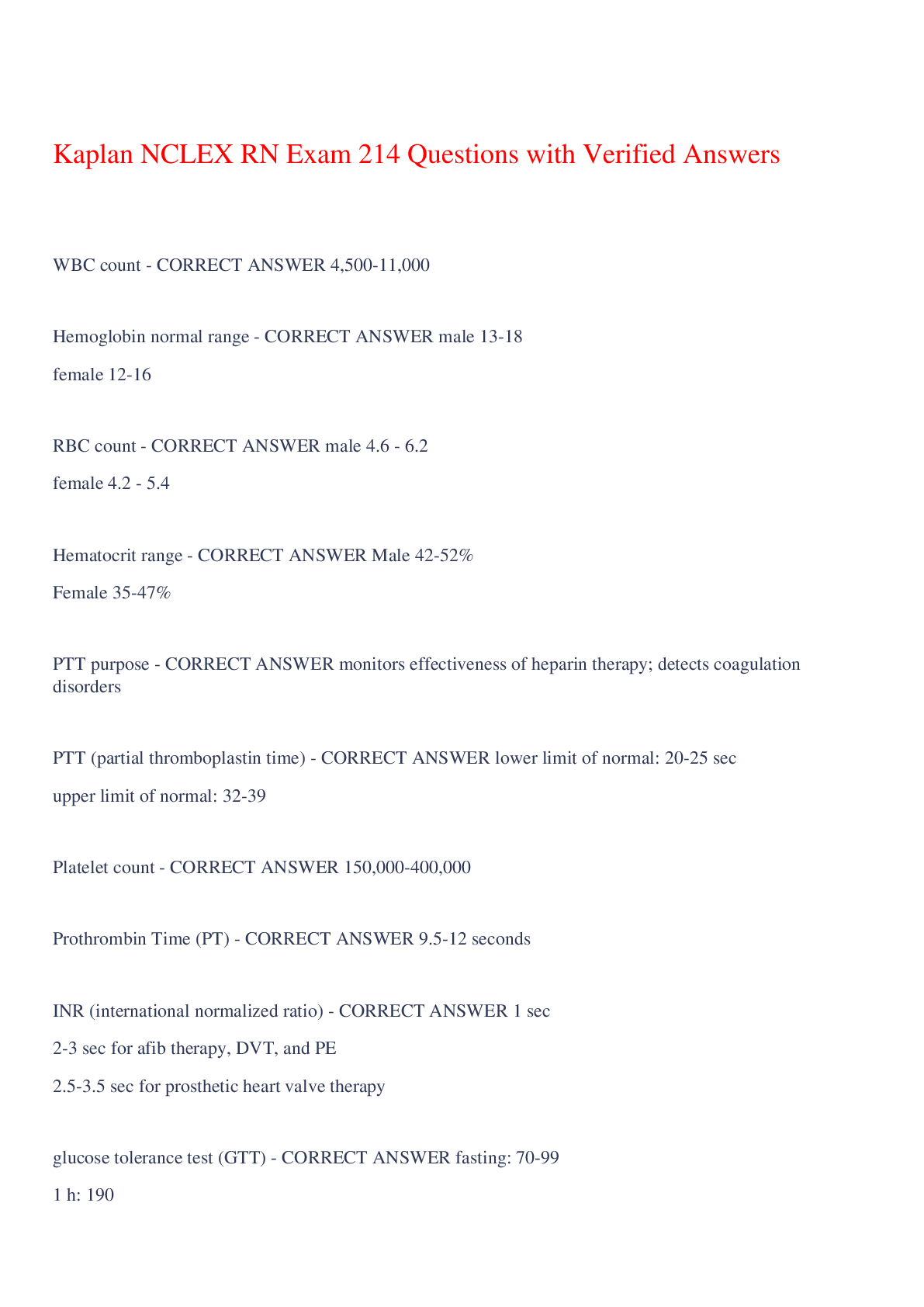
Buy this document to get the full access instantly
Instant Download Access after purchase
Add to cartInstant download
We Accept:

Reviews( 0 )
$12.00
Document information
Connected school, study & course
About the document
Uploaded On
Nov 13, 2023
Number of pages
31
Written in
Additional information
This document has been written for:
Uploaded
Nov 13, 2023
Downloads
0
Views
64














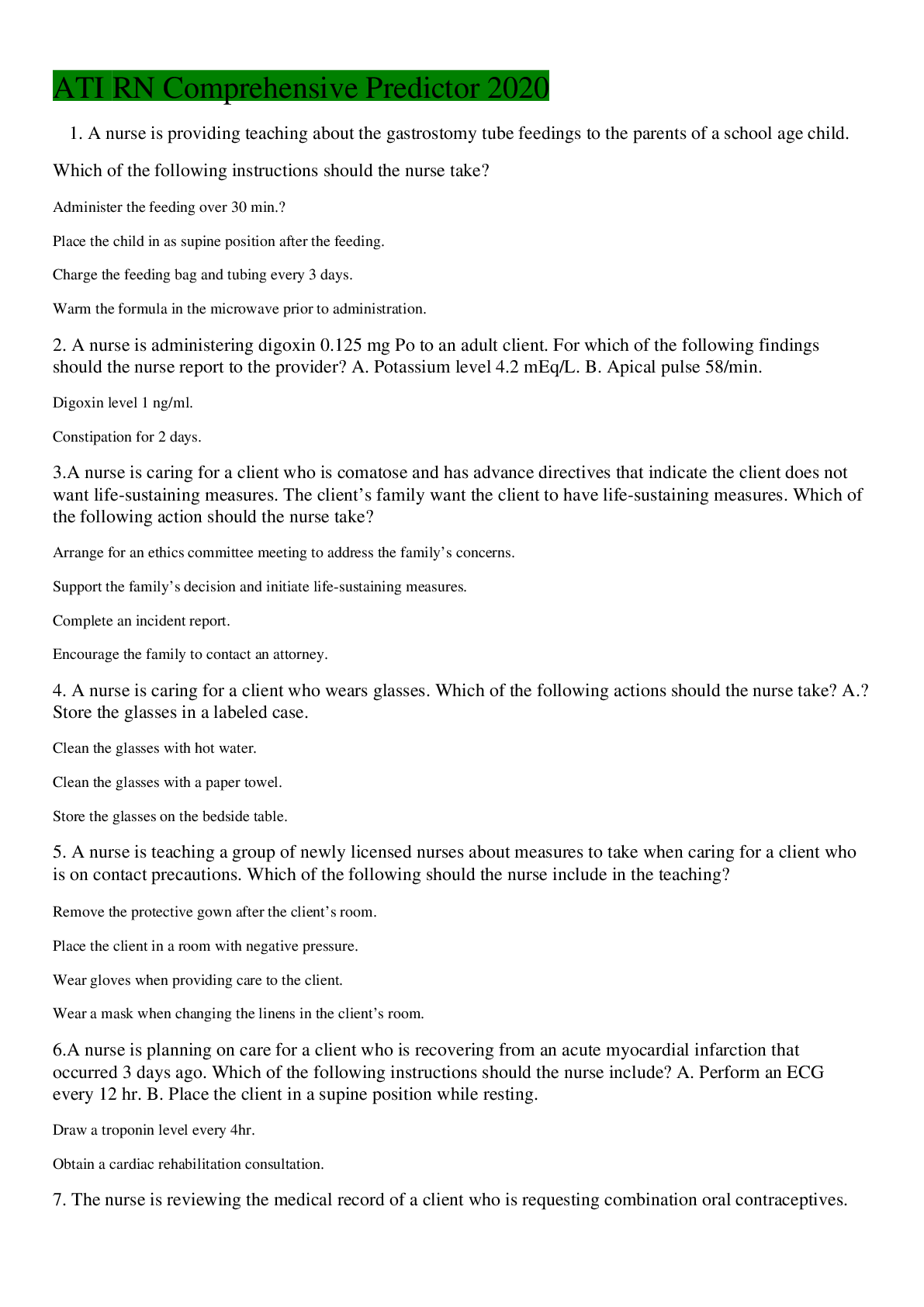

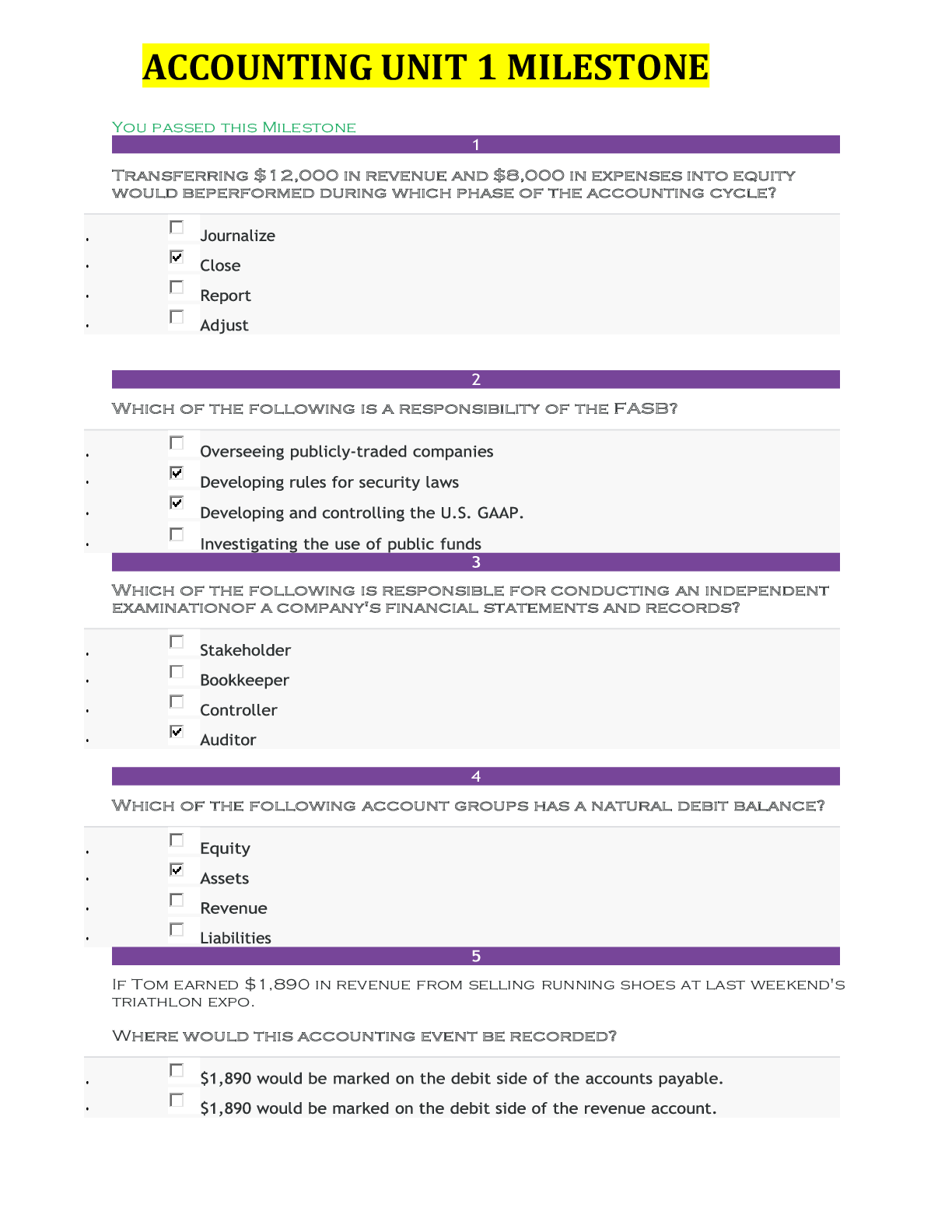
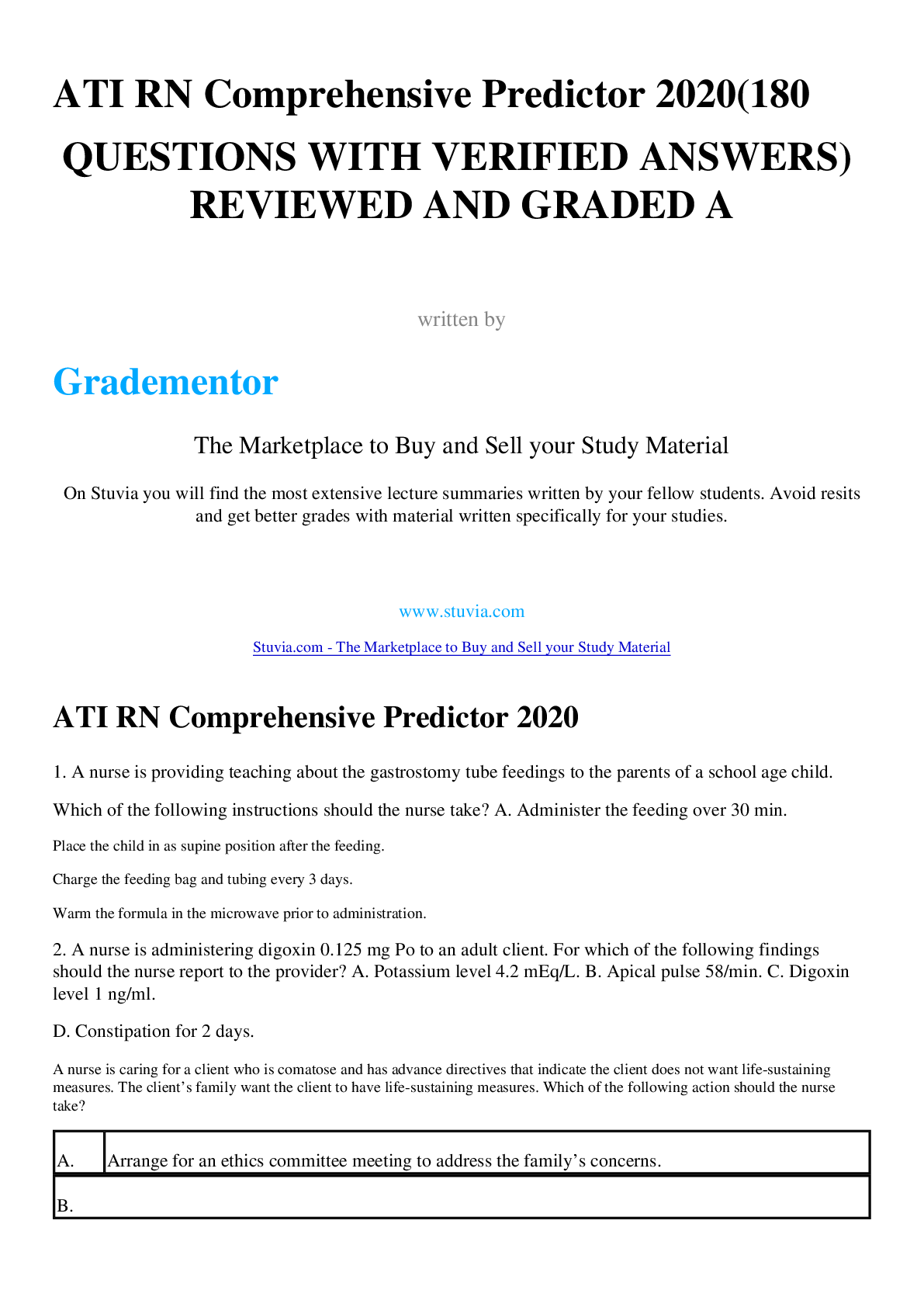
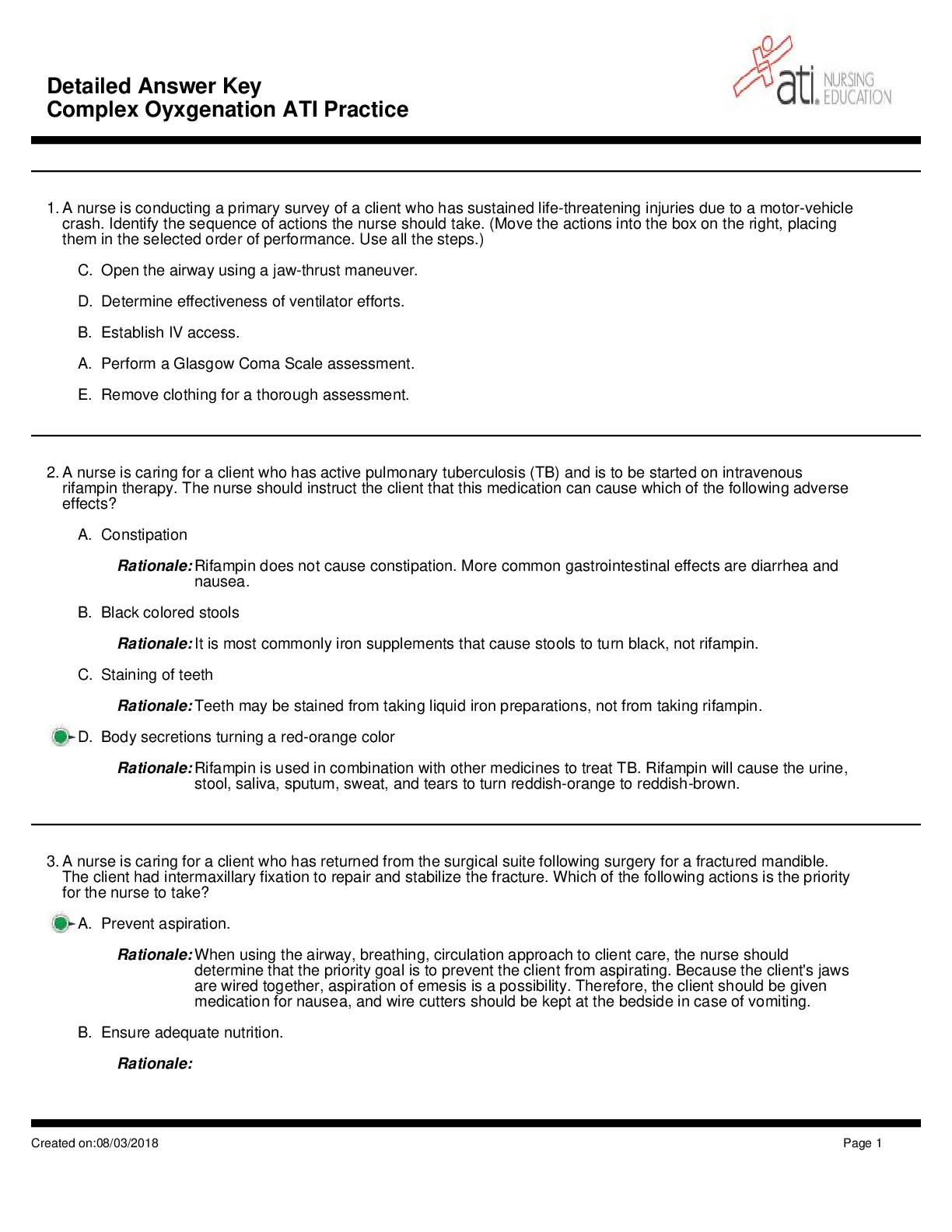
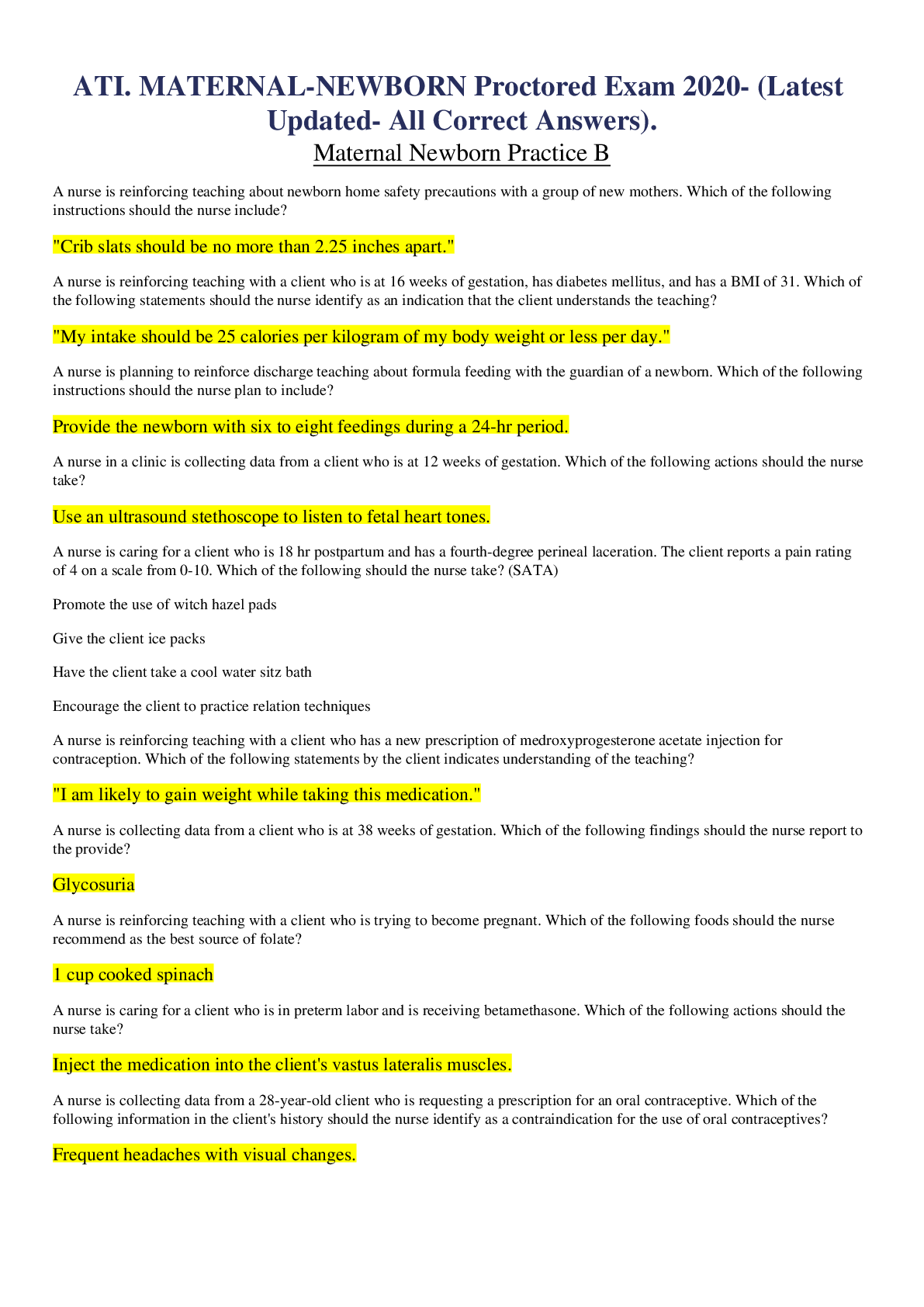
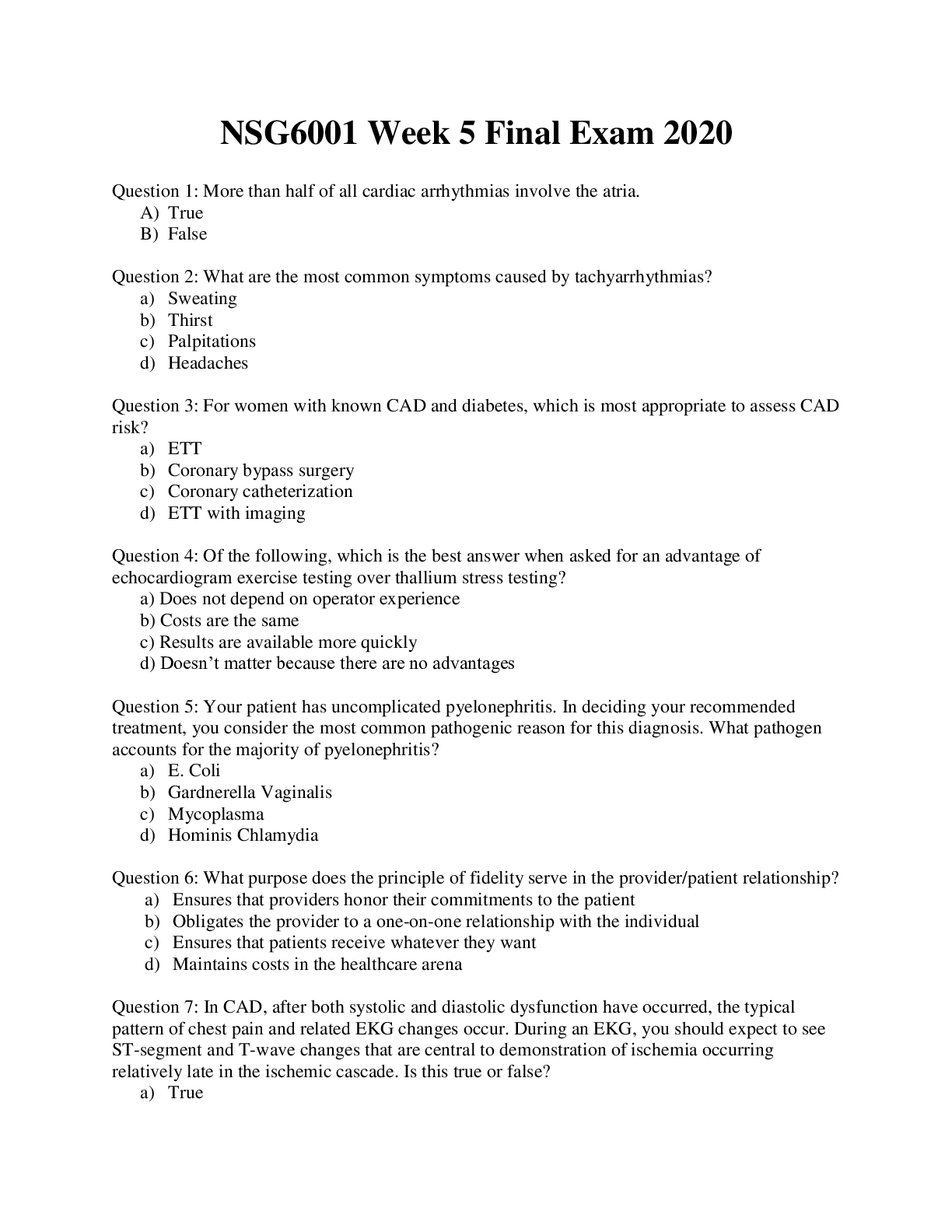

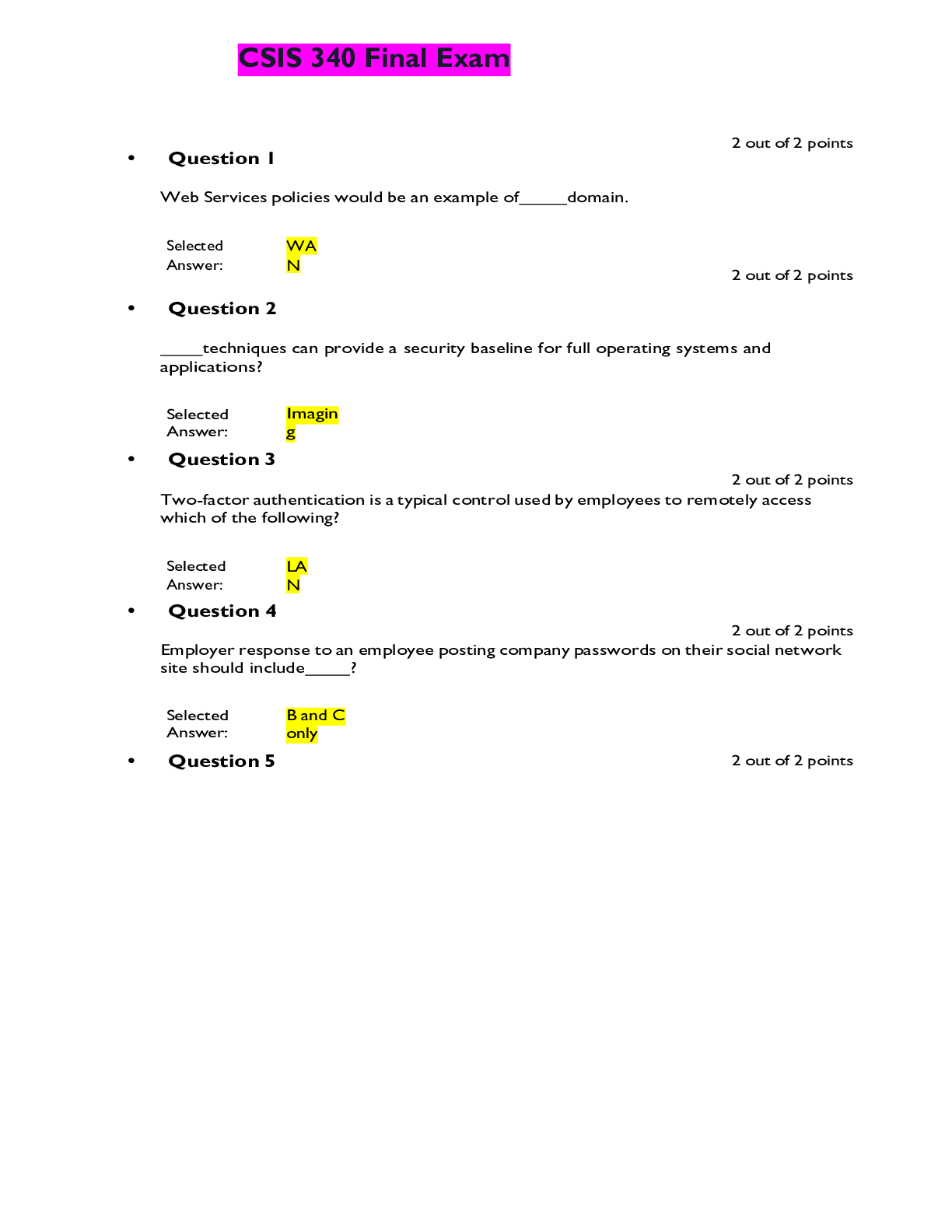

 (1).png)


